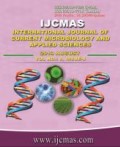


 National Academy of Agricultural Sciences (NAAS)
National Academy of Agricultural Sciences (NAAS)

|
PRINT ISSN : 2319-7692
Online ISSN : 2319-7706 Issues : 12 per year Publisher : Excellent Publishers Email : editorijcmas@gmail.com / submit@ijcmas.com Editor-in-chief: Dr.M.Prakash Index Copernicus ICV 2018: 95.39 NAAS RATING 2020: 5.38 |
Respiratory tract infections are among the most common infections in India. Multiple etiological agents are involved in the causation of these infections. Swine flu H1N1 is one among the influenza viruses which has great potential to cause epidemics as well as pandemics with great mortality and morbidity. All the suspected cases should be identified at the earliest so that interventions can be taken to prevent the spread of infections and thus contain the outbreaks. Molecular methods like PCR is extremely important for the diagnosis of these viral infections Aims and objectives: The present study aims to know the prevalence of Swineflu H1N1 infections by using Truenat H1N1 micro PCR system in and around Kurnool with a special emphasis on the outbreak of infection and to understand the clinical and demographical distribution of these cases. Methodology: This was a prospective study done during the swine flu epidemic period of September 2018 to Nov 2018. All the suspected cases belonging to Category C were kept in isolation ward and laboratory testing for H1N1 was done for these cases. Nasal or throat or nasopharyngeal swabs were collected by nylon swab and transported in the viral lysis medium and nucleic acid was detected by Truenat H1N1 micro PCR assay as per the manufacturer protocol Results : A total of 102 samples were tested during the study period out of which 48(47%) were positive for H1N1 swineflu. Out of these 48 cases 18 patients died with a mortality rate of 37.5%. People in the age group 35-50 years were predominantly affected. The associated comorbid conditions included hypothyroidism (11%), CKD (11%), preexisting lung diseases (COPD and H/o previous TB) (11%) and diabetes (11%). Hemoptysis was associated with increased mortality which was only observed in the death cases (22%). Decreased platelet count was also commonly observed among the death cases when compared to other positive cases (22% Vs 4%). Conclusion: Continuous surveillance for swineflu cases in extremely important in the early diagnosis of cases which in association with the early initiation of treatment and infection control practices will not only decreases the mortality but also prevents the spread of epidemics.
 |
 |
 |
 |
 |